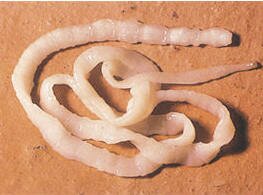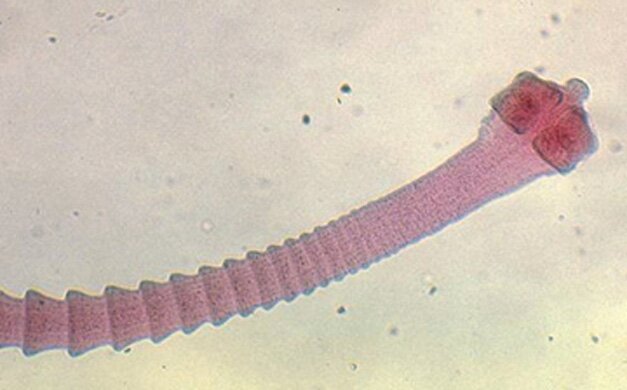Canine tapeworm (Dipylidium caninum)

 Canine tapeworm (Dipylidium caninum). The most common tapeworm among dogs, cats, foxes and other carnivorous animals. The development of a canine tapeworm is complicated. Indirect hosts are fleas and lice, which assimilate tapeworm eggs from the environment. In the body of the host, a subsequent transformation of tapeworm eggs takes place. As the host grows, the eggs convert into an invasive form and can infect the final host: dog, cat or an accidental man that ensures its further transformation. The human canine tapeworm infection occurs very rarely, but people shouldn’t undestimate this disease. Sometimes, an adult person can be infected with this parasite, although a majority of infection cases regard children who do not wash their hands after a direct contact with animals, kissing them, taking their fingers into their mouth, licking things picked up from the floor or dirty toys and food.
Canine tapeworm (Dipylidium caninum). The most common tapeworm among dogs, cats, foxes and other carnivorous animals. The development of a canine tapeworm is complicated. Indirect hosts are fleas and lice, which assimilate tapeworm eggs from the environment. In the body of the host, a subsequent transformation of tapeworm eggs takes place. As the host grows, the eggs convert into an invasive form and can infect the final host: dog, cat or an accidental man that ensures its further transformation. The human canine tapeworm infection occurs very rarely, but people shouldn’t undestimate this disease. Sometimes, an adult person can be infected with this parasite, although a majority of infection cases regard children who do not wash their hands after a direct contact with animals, kissing them, taking their fingers into their mouth, licking things picked up from the floor or dirty toys and food.
Canine tapeworm presence symptoms in animals
- vomiting
- diarrhoea
- enlarged stomach
- loss of weight and growth impede are caused by bowel mucosa damage which adversely affects digestion and assimilation by depriving the host of a plenty of essential substances necessary for a normal growth
- nervous symptoms, metabolites (neurotoxins) excreted by parasites affect the nervous system
- fur getting dull
The disease process
Dogs, cats, foxes and others carnivorous animals are the final hosts of a canine tapeworm. A mature tapeworm locates itself in the small bowel of the final host, and when it gains its sexual maturity, it starts to reproduce. Uterine segments filled with eggs separate from the tapeworm and are excreted from the body of the host or they crawl out from the anus and embed on the fur around the anus.
Tapeworm segments are white and their shape is similar to cucumber or pumpkin seeds and have a capability of shrinking and moving for a short period of time. The excreted segments of the tapeworm get dry and come apart releasing groups of eggs gathered in bags, which have to be picked up by indirect hosts to allow further growth.
Infection sources
The fact that the infection is very common among carnivorous animals is caused by a wide proliferation of fleas and lice. Carnivores scratch, lick and bite the itchy fur with their teeth and they simply swallow a flea or louse which contain an invasive form of the canine tapeworm in its body. Young tapeworms that get into the digestive system of the final host together with a flea or louse, transform into mature tapeworms. After 2-3 weeks from the infection, the first uterus segments filled with eggs are excreted by the animal.
Who is the most likely to get infected
The infection rarely affects a human. It can occur when a flea or louse containing an invasive canine tapeworm gets into the human digestive system where in the small bowel, it grows up. Most infection cases concern children who do not wash their hands after a direct contact with animals, kissing them, taking their fingers into their mouth, licking things picked up from the floor or dirty toys and food. Infected adults usually show no symptoms.
Children infection symptoms
- alimentary system disorders like: indigestion, loss of appetite, stomachache resulting from bowel mucosa damage.
- nervous disorders caused by metabolites (neurotoxins) excreted by parasites






